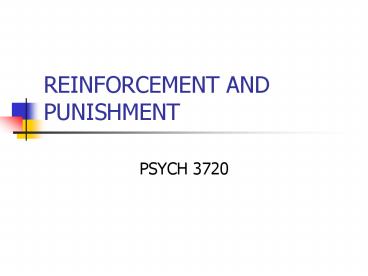REINFORCEMENT AND PUNISHMENT - PowerPoint PPT Presentation
1 / 39
Title:
REINFORCEMENT AND PUNISHMENT
Description:
THORNDIKE. Proposed the law of effect. Response followed by a satisfying ... Both Thorndike and Skinner claimed that punishment is ineffective in controlling ... – PowerPoint PPT presentation
Number of Views:1051
Avg rating:3.0/5.0
Title: REINFORCEMENT AND PUNISHMENT
1
REINFORCEMENT AND PUNISHMENT
- PSYCH 3720
2
REINFORCEMENT AND PUNISHMENT
- Review of traditional theories of reinforcement
and punishment. - Pavlov, Thorndike, and Skinner, Hull.
3
PAVLOV
- Biologically meaningful stimuli elicit survival.
- Promoting reflexes.
4
PAVLOV
- new behaviours can be learned by the
association of these reflexes with neutral
stimuli.
5
THORNDIKE
- Proposed the law of effect.
- Response followed by a satisfying state tend to
increase. - Responses followed by an aversive state
(annoyers) tend to decrease in frequency.
6
SKINNER
- Defined reinforcement as the process of
increasing the probability of response by
applying a reinforcer.
7
HULL
- Drive reduction theory of behaviour.
- Hull attempted to predict performance in a
learning task by specifying physiological and
psychological variables. - Physiological needs induced drives that when
reduced reinforced behaviour.
8
Modern views
- Many activities we engage in are pleasurable in
spite of the fact that our survival doesnt
depend on them. - Many do not involve drive reduction but they do
produce pleasure.
9
MODERN VIEWS
- Social approval may be one of the most effective
reinforcers for both children and adults but is
it drive reducing?
10
BANDURA
- Social reinforcement theory.
- Argues that much of human behaviour is imitative
and persists in the absence of overt reinforcers. - Social reinforcers.
11
NEGATIVE REINFORCEMENT
- Remember that reinforcement of any kind including
negative reinforcement increases the rate of the
preceding response.
12
ESCAPE AND AVOIDANCE PROCEDURES
- SIDMAN ESCAPE AND AVOIDANCE PROCEDURES.
- Learn via negative reinforcement.
13
DETERMINANTS OF AVOIDANCE RESPONSE RATES
- Shock intensity.
- Passage of time.
14
DISCRETE TRIAL AVOIDANCE SCHEDULES
- A specific discriminative stimulus is added to
the experimental environment. - Signaled discrete trial avoidance.
- Shuttle box.
15
WHAT IS THE REINFORCEMENT IN NEGATIVE
REINFORCMENT?
- How can the absence of a stimulus reinforce
behaviour? - Logically we presume that some aspect of the
reinforcer is always there. - Memory.
16
TWO-FACTOR THEORY OF AVOIDANCE
- Mowrer (1947).
- Suggested that there are two factors underlying
avoidance behaviour. - Classically conditioned emotional behaviour.
- Conditioned motor responses.
17
EXPERIMENT
- Kamin, Brimer, and Black (1963).
- Phase 1 rats trained to bar press for food.
- Phase 2 shuttle-box training where a tone set
the occasion for avoidance behaviour.
18
EXPERIMENT
- Four groups trained to avoid shock on 1,3,9, 27
consecutive trials. - Phase 3 a groups returned to the bar press for
food. Tone was presented while bar pressing and
the effect of the tone on response rate was
recorded.
19
RESULTS
- The tone produced different levels of responses
in each group. - 3,9 trials to criterion groups suppressed to the
tone. - 27 trials to criterion group did not suppress to
the tone.
20
RESULTS
- The latter group shows a high level of
proficiency at the avoidance task but is less
fearful.
21
STRENGTH
- Avoidance responses extinguish slowly because the
consequence of responding is reinforcement and
the consequence of not responding is punishment.
22
PUNISHMENT
- PSY 3720
23
PUNISHMENT
- A response has produced an aversive consequence.
- A ticket and associated fine.
24
PUNISHMENT
- Response tendencies that diminish because they
produce aversive consequences define the process
of punishment.
25
OTHER EXAMPLES OF PUNISHMENT
- Withholding a positive stimulus.
- Examples.
26
WHAT IS PUNISHING?
- Innate or primary punishers.
- Acquired or secondary punishers.
27
EFFECTIVENESS
- Both Thorndike and Skinner claimed that
punishment is ineffective in controlling
behaviour. - The general public feels that punishment is
highly effective.
28
EFFECTIVENESS
- Modern views suggest that under the right
conditions punishment can have specific and
long-lasting effects on behaviour.
29
PUNISHMENT IS ASSOCIATIVE
- Both punishment training and classical
conditioning are largely determined by
30
PUNISHMENT IS ASSOCIATIVE
- Classical conditioning and punishment procedures
share the common effects of
31
SKINNERS PUNISHMENT EXPERIMENT
- Used a spring-loaded lever that slapped the rat
in the paw if it bar pressed for food. - Low intensity aversive stimulus.
- Showed response suppression but during extinction
the response quickly returned to baseline levels. - Skinner concluded that punishment was ineffectual.
32
OTHER FACTORS INFLUENCING THE EFFECTIVENESS OF
PUNISHMENT
- TRIALS EFFECT the more that responses are
punished, the lower is the subsequent response
rate. - RESPONSE-PUNISHMENT INTERVAL RULE the shorter
the response-to-punishment interval, the more
effective is the punishment treatment.
33
PUNISHMENT AND DELAY
34
Applied approaches
35
EXPERIMENT
- Subjects were trained to bar-press for food.
- After reaching baseline levels each pecking
response was punished with a mild electric shock. - Resulted in a half the rate of responding.
- These trials were alternated with non-punished,
non-food reinforced sessions.
36
RESULTS
- The subjects eventually learned to continue
responding for food if their responses were
punished and to stop responding if they were not
punished.
37
MASOCHISTS
- Is it possible that masochists learn to use pain
as a discriminative stimulus for pleasure?
38
ABUSIVE RELATIONSHIPS
- Many abused women do not leave their husbands or
if they do return soon after? - This behaviour seems maladaptive and women are
often criticized for putting themselves in harms
way.
39
ABUSIVE RELATIONSHIPS
- What reinforcement and punishment contingencies
are present?































